

Visible Learning Archives. Welcome to the second day of the Visible Learning World Conference in London.
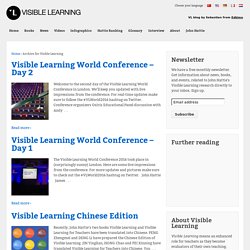
We’ll keep you updated with live impressions from the conference. For real-time updates make sure to follow the #VLWorld2016 hashtag on Twitter. Conference organizers Osiris Educational Panel discussion with Andy… The Visible Learning World Conference 2016 took place in (surprisingly sunny) London. Here are some live impressions from the conference. Recently, John Hattie’s two books Visible Learning and Visible Learning for Teachers have been translated into Chinese. “Improving Schools through Visible Learning: Research, Practice and Impact”. Learning as conversation.
Diana Laurillard’s conversational framework feels like a very powerful model for understanding how formal learning works and how best to design effective learning objects.
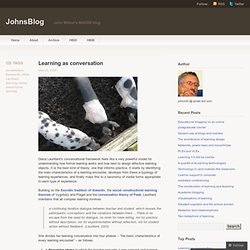
It is the best kind of theory: one that informs practice. It starts by identifying the main characteristics of a learning encounter, develops from these a typology of learning experiences, and finally maps this to a taxonomy of media forms appropriate to each type of experience. a continuing iterative dialogue between teacher and student, which reveals the participants’ conceptions and the variations between them… There is no escape from the need for dialogue, no room for mere telling, nor for practice without description, nor for experimentation without reflection, nor for student action without feedback.
(Laurillard, 2002) She divides her learning conversation into four phases – “the basic characteristics of every learning encounter” – as follows: Here’s my attempt at an answer.. Reference: Laurillard, D, 2002. Literacy Design Collaborative. LDC "teaching tasks" are the meaningful reading and writing assignments that teachers “teach” and students “do” to demonstrate they have learned college and career skills.
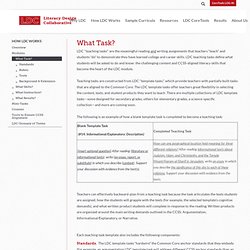
LDC teaching tasks define what students will be asked to do and know: the challenging content and CCSS-aligned literacy skills that become the heart of the LDC module. Teaching tasks are constructed from LDC “template tasks," which provide teachers with partially built tasks that are aligned to the Common Core. The LDC template tasks offer teachers great flexibility in selecting the content, texts, and student products they want to teach. There are multiple collections of LDC template tasks—some designed for secondary grades, others for elementary grades, a science-specific collection—and more are coming soon. The following is an example of how a blank template task is completed to become a teaching task: Each teaching task template also includes the following components: Standards. Rubrics. Texts. Support Yes.
Teacher Collaboration: When Belief Systems Collide. It's impossible to explore how we can work more effectively together in schools without considering conflict -- an inevitable part of working together.
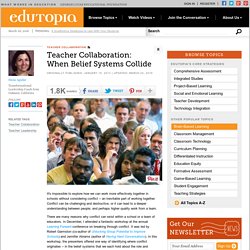
Conflict can be challenging and destructive, or it can lead to a deeper understanding between people, and perhaps higher quality work from a team. There are many reasons why conflict can exist within a school or a team of educators. In December, I attended a fantastic workshop at the annual Learning Forward conference on breaking through conflict. It was led by Robert Garmston (co-author of Unlocking Group Potential to Improve Schools) and Jennifer Abrams (author of Having Hard Conversations).
In this workshop, the presenters offered one way of identifying where conflict originates -- in the belief systems that we each hold about the role and purpose of education. 6 Belief Systems In his book, Cognitive Coaching, Robert Garmston (with co-author Arthur Costa) identifies six predominant ideologies that influence educators' decision-making: 25 Of The Best Pinterest Boards In Education. Blogs and Twitter aren’t the only social tools out there that can help you keep up with the latest and greatest developments in educational technology.
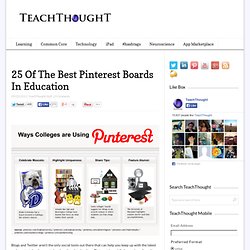
Pinterest is rapidly becoming a favorite tool of educators all over the nation, and many have amassed some pretty great collections of edtech-related pins that teachers and students alike can use to explore new ways to learn, share, teach, and grow. While it would be nearly impossible to highlight every edtech pinboard out there, we’ve shared some of the boards we think stand out among the crowd here.
Many are maintained by major educational websites, key figures in edtech, and well-known bloggers, but others were created by teachers just like you who simply want to share resources and tips with others in education. Oh–and don’t forget TeachThought’s burgeoning Pinterest board! 12 Trends Disrupting the Market for Lifelong Learning. Google Trends shows BIG growth in MOOC interest this year.

I wrote this post as we were headed into 2013, but there is nothing here that has diminished in importance over the past year. In fact, most of these are much more important in 2014. So, give it a read, share it with others, and please comment, too, on what you are doing in relation to any of these trends. (Note: I have not actually attempted to rank these – the numbers are just there for the sake of numbering.) 1. Social Learning in Education. Websites for Educators. Studying Teaching and Learning. Building a Better Teacher.